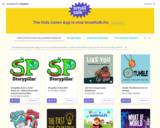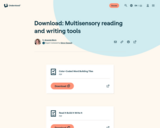
A great resource for getting started with The Daily 5.
- Subject:
- English Language Arts
- Material Type:
- Teaching/Learning Strategy
- Author:
- Jayne Haenel
- Gail Boushey and Joan Moser
- Date Added:
- 11/30/2018

A great resource for getting started with The Daily 5.

The Daily Five is a literacy structure that allows for differentiation in the classroom and provides consistency. • It is an integrated literacy instruction and classroom management system for use in reading and writing workshops. • It is a system of five literacy tasks that teaches students independence.
This site supports the use of Daily 5. The free membership allows you access to the tip of

his short video will give you a brief explanation of how I run my Daily 5 rotations and how my rotations are set up on my Daily 5 Rotations board.

Find podcasts on a variety of topics for pretty much every subject area.
*Great for Daily 5.
*Tons of stories and more!
Kids Listen is a grassroots organization of advocates for high-quality audio content for children.

This resource has a variety of resources for primary grades. Great information is available here for free.
There are also resources available that you can purchase through teachers pay teachers.
The Short Vowel, no prep is perfect for word work in the daily 5.

Multisensory Tools for Reading and Writing
Color-Coded Word Building Tiles (View / Download)
Read It, Build It, Write It Mat (View / Download)
Story Stick Questions (View / Download)
Multisensory instruction can help kids with reading and writing issues gain basic skills. It works by engaging more than one sense at a time. Multisensory teaching doesn’t have to be limited to school. You can use some techniques at home.

No Red Ink is an online site that helps students specifically with grammar. It gives quizzes and exercises tailored to that students’ interests (sports, celebrities, etc) and offers a number of different differentiated platforms and games.
You have to sign up to use this for your students. Some features are locked for paid accounts, but that being said, there are a number of excellent activities for free as well!
Students complete a diagnostic test, do the practice and then write an assessment.
*grammar
*writing prompts
*skill building
*reading response
*bell ringers
*exit tickets
*fluency
*persuasion
*informational texts
*novel activities

Check out these 19 categories of great science podcasts that you can listen to with kids. Many of the categories have a number of podcasts within. Topics include oceans, dinosaurs, light, sound, space, senses, animals , plants and much, much more!
Did you know that there’s a listening app with ONLY content for kids?! It’s called Kids Listen, and it features a playlist curated especially for educational shows! Check it out at https://app.kidslisten.org, or as an Apple or Google Play app. What a great way to let your kids discover what they love.

This resource contains a collection of excellent writing prompts for elementary students. The prompts are specifically listed until Grade 4, but many of these are great prompts that could be used with any age student!